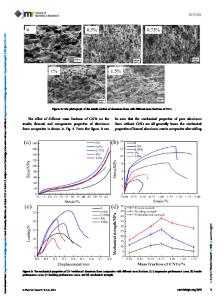Spatial Variations in the Mechanical Properties and Electrical Properties of Carbon Nanotube Turfs
- PDF / 1,263,124 Bytes
- 6 Pages / 612 x 792 pts (letter) Page_size
- 8 Downloads / 370 Views
1258-R10-29
Spatial Variations in the Mechanical Properties and Electrical Properties of Carbon Nanotube Turfs A. Qiu1, M.C. Lopez1, A. Bellou1, D. McClain2, J. Jiao2, D.F. Bahr1 1 Mechanical and Materials Engineering, Washington State University, Pullman WA 99164-2920 USA 2 Department of Physics, Portland State University, Portland OR 97207-0751 USA ABSTRACT The mechanical properties of arrays of nominally vertically aligned carbon nanotubes, often referred to as turfs, have been measured using nanoindentation and the electrical properties have been measured using electrical contact resistance (ECR) nanoindentation. The elastic properties do not vary significantly between the top and the bottom of the same carbon nanotube turf. Within a single turf the lateral spatial variation is less than 10% when volumes of µm’s are probed with the indenter, indicating that each turf can be treated mechanically as continuum on this scale. The electrical properties vary significantly within a single turf on the same scale. This suggests that the use of average mechanical properties for a given vertically aligned turf should be suitable for design purposes without the need to account for spatial variation in structure, and variations in mechanical properties on the micrometer scale are not dependent on spatially distinct defects. However, local contact behavior appears to dominate the electrical behavior on this same length scale. INTRODUCTION Arrays of carbon nanotubes (CNTs) in nominally vertical orientations have been demonstrated in a wide variety of applications, from thermal interface materials1 to varactors2 to field emitters3. These bundles of nanotubes in a brush or turf-type geometry are often grown via chemical vapor deposition from catalysts; variations in catalyst structure can alter the resulting structure of the CNTs, which may impact the properties of the turf. Thermal properties have been shown to be sensitive to these structural changes4. The mechanical response of turf structures has also been suggested to be sensitive to structural changes; Cao and co-workers noted that buckling behavior may be linked to local density variations5, with the growth side of a turf having a less dense structure (and therefore a lower stiffness). Other research on the mechanical properties of turfs6,7 has shown that the effective properties vary with extent of deformation and morphology, and suggested that resulting buckling behavior in the array is dominated by the difference in stiffness between a rigid substrate and the compliant turf8. Recent studies of localized buckling that occurs during point contact have noted that mechanical responses in very dense CNT brushes grown without catalysts can exhibit size dependent strengths, which the authors ascribe in part to spatial variations in defect density9. This type of behavior has led researchers to suggest that CNTs in these turf and brush formats may be used for energy dissipation during contact. Published reports of diffraction experiments have noted that spatial variations in t
Data Loading...











